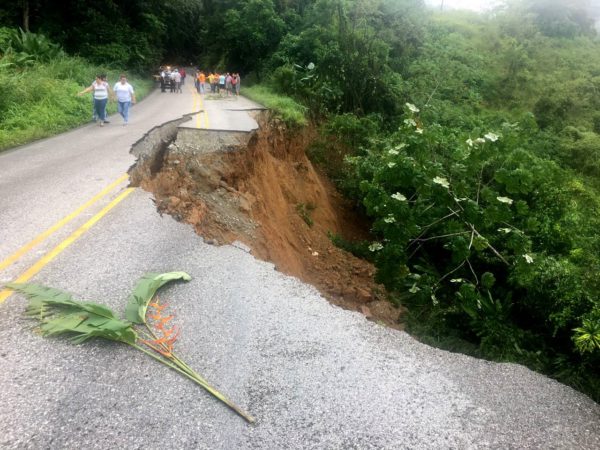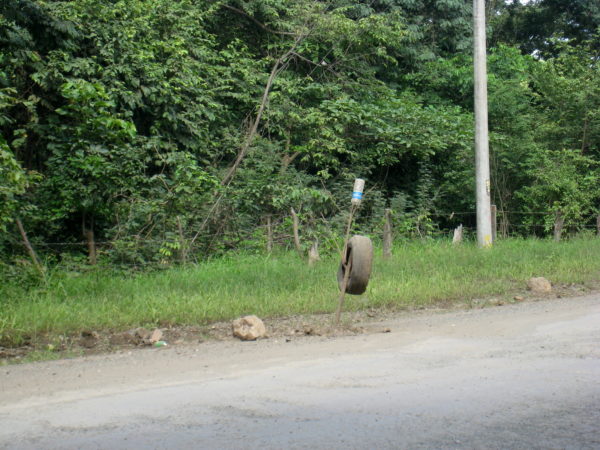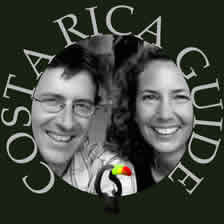“The Arenal volcano tour ends with a sunset mirador at 5:30 p.m. so we’ll just pack and drive up to Monteverde for dinner then…” — More like breakfast if you’re lucky.

Although a few km of modern highway are added to Costa Rica’s road system each year driving at night on most routes is not for the inexperienced.
Sunset is between 5:30 and 6:00 p.m. year round and in the tropics it’s pitch black dark shortly after. Driving a few km back to your lodge after dinner is usually okay if you’re cautious but setting off for your next destination is not advised.

The roads are narrow, winding, steep and often in poor condition. It’s normal to find a hairpin corner with a hundred foot drop off but no painted lines, no reflectors, no lights and no guardrails. Besides the roads themselves there are the added hazards of people and animals, fallen trees and branches and landslides that either drop rocks and mud onto the road or drop the road into a canyon.
As if that weren’t enough the minster of transportation warns that a high percentage of drivers are drunk at night. An alcoholic friend of ours once told us that in his region at least half of the drivers after 8:00 p.m. were drunk. He claimed he knew that for a fact because he’d just left the bar with them.
“it’s okay, I did it” | tips for rain | new roads
Inclement Weather
Sounds like it couldn’t be much worse, but it can – 75% of Costa Rica’s rain falls overnight. That means it’s four times as likely you’ll have to add blinding rainstorm and wet slick road to the list of hazards when comparing night and day. Pea soup fog also forms late at night or early in the morning on most nights in the mountains.
Don’t be fooled into thinking if you’re visiting in the dry season from January through April that you don’t have to worry. While the Pacific northwest may go for months without significant precipitation, the eastern half of the country does not have a dry season and overnight downpours are not uncommon any time of the year on the Caribbean.
Some of Costa Rica’s most popular attractions (like Arenal volcano mentioned above) are on the wet Caribbean side of the continental divide.

In the photo above the heliconia flower is the quaint old fashioned way to warn of a hazard. Now every vehicle is required by law ($250 fine) to carry reflective safety triangles but imagine coming around a corner at night in the rain to the landslide pictured above. If you’re the first one there you’re probably never going to get a chance to deploy your reflective triangles…
Admittedly as cartographers mapping Costa Rica’s roads we drive a lot but we see at least one spot where the road is just plain gone an average of once a year. We knew one person – a local who drove the same road for 40 years – who later died of his injuries after dropping into a ravine driving at night.
“it’s okay, I did it” | tips for rain | new roads
Brand New Roads are a Hazard?
The only thing worse than the cracked and crumbling, sixteen times patched goat paths through the mountains are the tantalizingly smooth segments of glassy black new pavement. At least the potholes filled with water or multi-shaded splotches of concrete and asphalt provide some contrast hinting at where the road is. “Unmarked asphalt” -black is indistinguishable from “yawining abyss” -black under your headlights.
It’s nearly impossible to follow an unlighted road at night without painted lines or reflectors and it’s typical for construction projects to run out of money before those little details are added. Add a rainstorm and you’ll have no choice but to park and wait for morning.
“it’s okay, I did it” | tips for rain | new roads
Don’t Forget the Rivers
New bridges are slowly going up over the rivers on the roads around the perimeters of the Nicoya and Osa peninsulas but there are still a few there and even some in the mountains that you have to drive through (see how to ford a river).


It’s impossible to even imagine having to say this but – do not walk or drive into a stream, creek, quebrada, river or estuary that you cannot see!
“It’s Okay, I Did It”
Inevitably someone will tell you “oh, I drove at night, no problem.” There are a couple of stretches of road where this is true sometimes. In the city and suburbs of the central valley there are street lights and buildings with lights. Even downtown there can be unexpected hazards like the gaping holes left when the man hole covers are stolen to be sold as scrap metal…
Some sections of Hwy 1, Hwy 2 and the toll road to the coast (Hwy 27) have lights, painted lines, reflectors and multiple lanes making them reasonably safe to drive at night.
I’ve driven over the Cerro de la Muerte (peak of death) at night in rain and fog and I’m still here to write about it so it’s obviously not fatal. I’ve also crawled across the wilds of Wyoming in four wheel drive in the middle of a blizzard at night on a dirt track with no markings and eight foot snow drifts.
Would I recommend either one? Of course not, but if I have to choose I’d say Wyoming is more survivable as long as I have my gear in the back of the truck.
Just be certain the route you choose to drive after dark is one that’s okay because it’s hard to convey how bad it is when it’s bad.



The Most Important Reason Not to Drive at Night
Last but not least if you’re driving at night you and your passengers are missing Costa Rica. Some of the worst roads to drive at night are the most breathtakingly beautiful during the day.

“it’s okay, I did it” | tips for rain | new roads
